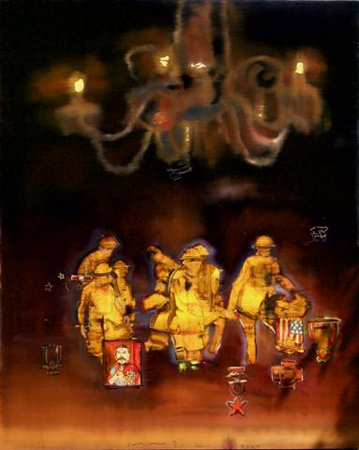Press
"Low Clouds and Fog" at Cassius King Gallery 2004
ART REVIEW FLYING SOLO 'Clouds' is local artist's first lone effort in two years By Robert L. Pincus ART CRITIC April 8, 2004 Some pictures become eerie by association. This is definitely the case with Jeremy Farson's "Vapor and Dust." The painting, if it stood alone, might make you think of war and carnage. Its title is true to the imagery. Soft billows, with large areas defined by orange and gray, rise from a flat landscape. It seems telling that this painting is installed at the beginning of the his exhibition, "Low Clouds and Fog." View the canvas at the outset and you might feel as if the signs of warfare in its imagery are pretty subtle - trails of vapor created by missiles. See it again, aftering viewing the rest of Farson's new paintings, and you'll feel sure all of the dust rising into a sickly colored sky is sinister. The rest of the show - the San Diego artist's first solo effort in two years - is quite direct in its focus on war. Much of the recurring imagery is of medals, soldiers, tanks and other implements of war. We can feel certain that the ugly situation in Iraq is the most immediate impetus for these pictures. But Farson makes no attempt at heavy-handed anti-war paintings and hurrah for that. So much social invective, whether in paintings or any other art form, falls flat. ---------------------------------------- DATEBOOK ---------------------------------------- "Low Clouds and Fog," a solo exhibition by Jeremy Farson Through May 1 Cassius King Gallery, 435 Third Ave., downtown Free (619) 232-5464 or www.cassiusking.com ---------------------------------------- Farson does something more interesting, at times well and at others with too much murk. He evokes the history of war, as if it were a primordial pool of imagery welling up from some shadow world. This obliquely narrative approach also connects his work to a good deal of painting and drawing by younger artists. "Ghosts of Mayhem" establishes Farson's approach most directly. Last year, he exhibited some convincing paintings of vacant, haunting lobbies, the decor suggesting early to mid-20th century vintage. There is a fragment of that interest in the out-of-focus chandelier that dangles high in "Ghosts of Mayhem"; below it are distinct phantoms of soldiers - possibly of World War I vintage. Medals float in the thick, dark air that surrounds them. The exact period of the military garb isn't key to the essence of these paintings. What matters most is the long view of war. Old conflicts turn fuzzy, like the soldiers in these pictures. The horrors of older military campaigns fade and we repeat the horrors anew, arguing for the urgency of current wars as virulently as governments of old did. That is the big picture here. "Nowhere Imperative" molds this point into metaphor. Farson blurs the boundary between different decades and centuries in the jumble of soldiers, tanks and other less identifiable things that fill the composition. In "Phantom Brigade," faces that peer out from helmets are virtually inseparable from the soupy atmospheric surface that envelops them. "Velocity Jump" may be the most formally ambitious picture in the show, with its abrupt shifts in scale. Tanks move across a landscape with giant boots. But the landscape is also a table or desk with fading photographs in frames. A gorilla at the margins of the scene is suggestive of how war ravages what remains of the the natural world as well as the places we populate. Farson's style has its pitfalls. The soft look of the imagery, coupled with its complexity, can veer toward muddiness instead of evocative atmospherics. That's the case with "Odious Front" and with small portions of other paintings. However, more paintings than not wrestle their large theme into cogent pictorial form. Far more than any overtly anti-war pictures could, they persuade you to ponder a big, brooding question: will the human race ever break the cycle of wars so central to our history? Farson's paintings aren't answers. They are simply symbolic images that linger in the mind and leave each viewer to ponder the dark aspect of the past and the present they envision. Robert L. Pincus: (619) 293-1831; [email protected] |
|

